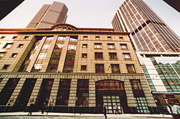
Fans Are Down; Awaiting Parts
Exactly this consideration, and the need to improve the reliability of the HVAC system, led to a recent VFD retrofit of the fans in one of the City of London's architectural landmarks, the 55 Bishopsgate building. "An upgrade was needed because the fan impeller units had worn and were causing numerous breakdowns," said Ian Cannell of C.S.M. Ltd. UK, the company that provided the solution on behalf of the property owner, Deka Immobiliem GmbH.Components within the fan impeller units would wear and then cause the positioning actuator to operate under severe strain; that, in turn, damaged the drive gearing and burned out control boards within the actuator. The actuator was replaced several times at a cost of $1,250, he noted.
Spare parts, essential for the mechanical repair/replacement, also were becoming hard to find. Waiting for them to arrive from continental Europe often created downtime extending up to eight months. "With no air conditioning on the affected floor, the tenants then expected a refund," said Cannell.
CSE Industrial Electrical Distributors, ABB's HVAC partner in London, supplied a total of 17 new VFDs for a retrofit, complete with IP54 enclosures; 15 drives rated at 7.5 hp; one at 10 hp; and two at 15 hp.
The impeller units were locked in optimum flow position, and two VSDs were installed on each floor; the drives were then set to vary the motor speed to match the airflow requirements of each floor. To avoid interrupting building users, all of the retrofit work was completed over a period of weekends.
"Once you lock, rather than vary, the pitch of the fans, you immediately remove from the operation equation most of the moving mechanical parts that create all the headache," noted Cannell. "With drives installed and impeller units set, 33 out of 33 moving parts - not including bearings and shaft - are used very minimally; the reduction in mechanical wear is exponential."
Easy, Economic Retrofit
The drives have improved the reliability of the system and reduced maintenance radically, according to Cannell. The system also draws less energy now that the fan speed is controlled via VSD, he said.Other benefits of retrofitting VFDs to this type of fan are increased power factor (.98 lagging displacement power factor regardless of load), according to Miller. "The soft start/stop feature that VFDs provide virtually eliminates mechanical wear-and-tear and the lower fan rpm operation at reduced loads minimizes audible fan noise," he said.
The actual retrofit this type of application is extremely easy, according to ABB, as the setpoint controls already exist. "Adding a 'hub locking kit' to lock the fan blades at full flow is all that is required," said Miller.
Downtime at the Bishopsgate facility has disappeared following the drive retrofit, according to C.S.M. There have been no breakdowns of AHUs, no unscheduled stoppages, no need for belt changes, and belt tensions have not been altered. "If you calculate the cost of downtime, handling builder user complaints and tenant demands for refunds when A/C is not working, the time for full payback on the costs of this kind of drive retrofit gets very short," said Miller.ES
